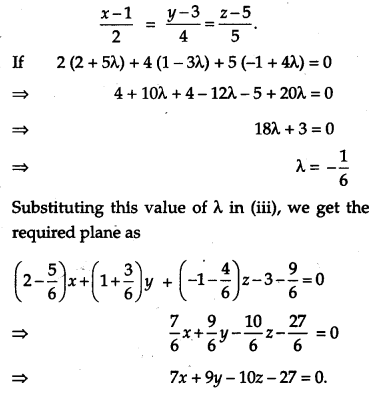CBSE Previous Year Question Papers Class 12 Maths 2011 Outside Delhi
Time allowed: 3 hours
Maximum marks : 100
General Instructions:
- All questions are compulsory.
- The question paper consists of 29 questions divided into four sections A, B, C and D. Section A comprises of 4 questions of one mark each, Section B comprises of 8 questions of two marks each, Section C comprises of 11 questions of four marks each and Section D comprises of 6 questions of six marks each.
- All questions in Section A are to be answered in one word, one sentence or as per the exact requirement of the question.
- There is no overall choice. However, internal choice has been provided in 1 question of Section A, 3 questions of Section B, 3 questions of Section C and 3 questions of Section D. You have to attempt only one of the alternatives in all such questions.
- Use of calculators is not permitted. You may ask for logarithmic tables, if required.
**Answer is not given due to the change in present syllabus
CBSE Previous Year Question Papers Class 12 Maths 2011 Outside Delhi Set I
Section – A
Question 1.
Let A = {1, 2, 3}, B = {4, 5, 6, 7} and let f = {(1, 4), (2, 5), (3, 6)} be a function from A to B. State whether f is one-one or not. [1]
Solution:
Given,
A = {1, 2, 3},
B = {4, 5, 6, 7}
f = {(1, 4), (2, 5), (3, 6)}
f : A → B is defined as
∴ f(1) = 4, f(2)= 5, f(3) = 6.
Different points of the domain have different f-image in the range.
∴ f is one-one.
Question 2.
What is the principal value of
 [1]
[1]
Solution:
Given,
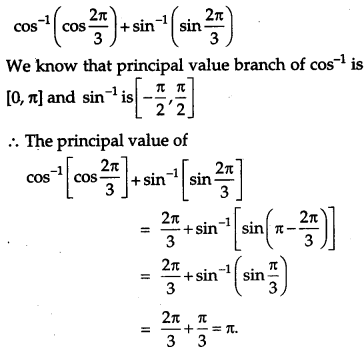
Question 3.
Evaluate:
 [1]
[1]
Solution:
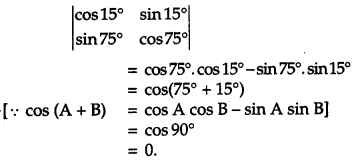
Question 4.
If A = \(\left[\begin{array}{cc}{2} & {3} \\ {5} & {-2}\end{array}\right]\) write A
-1
in terms of A. [1]
Solution:
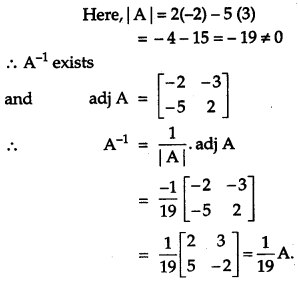
Question 5.
If a matrix has 5 elements, write all possible orders it can have. [1]
Solution:
Since a matrix of order m × n has mn elements therefore, to find all possible orders of a matrix with 5 elements, we have to fill all possible ordered pairs (m, n) of positive integers whose product is 5. Hence possible orders are 1 × 5 and 5 × 1.
Question 6.
Evaluate:
![]() [1]
[1]
Solution:
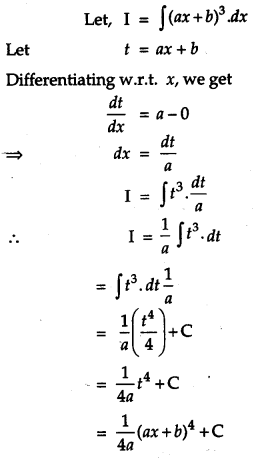
Question 7.
Evaluate:
 [1]
[1]
Solution:


Question 8.
Write the direction-cosines of the line joining the points (1, 0, 0) and (0, 1, 1). [1]
Solution:
The d.r’s of line joining points (1, 0, 0) and (0, 1, 1) are 0 -1, 1 – 0, 1 – 0 i.e. -1, 1, 1
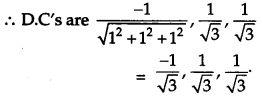
Question 9.
Write the projection of the vector \(\hat{i}-\hat{j}\) on the vector \(\hat{i}+\hat{j}\). [1]
Solution:
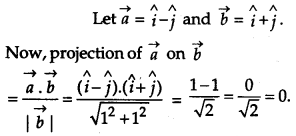
Question 10.
Write the vector equation of a line given by
![]() [1]
[1]
Solution:
The given line is
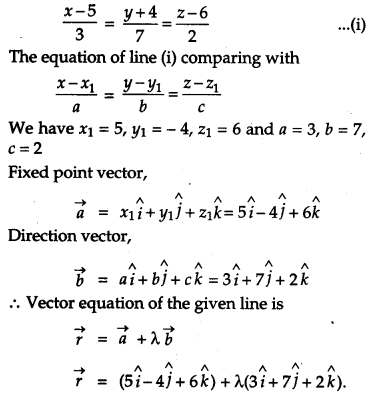
Section – B
Question 11.
Let f : R → R be defined as f(x) = 10x + 7. Find the function g: R → R such that gof=fog = I
R
. [4]
Solution:
It is given that f : R → R is defined as
f(x) = 10x + 7
One-one
Let f(x) = f(y), where x, y ϵ R
⇒ 10x + 7 = 10y + 7
⇒ x = y
∴ f is a one-one function.
Onto:
For y ϵ R, let y = 10x + 7
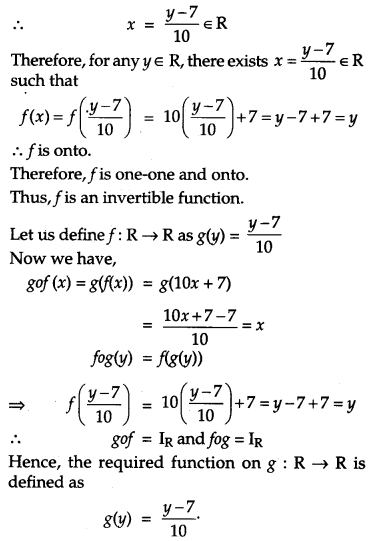
OR
A binary operation * on the set {0, 1, 2, 3, 4, 5} is defined as:

Show that zero is the identity for this operation and each element ‘a’ of the set is invertible with 6 – a, being the inverse of ‘a’.**
Question 12.
Prove that:
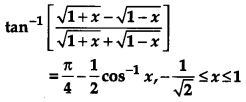 [4]
[4]
Solution:
L.H.S

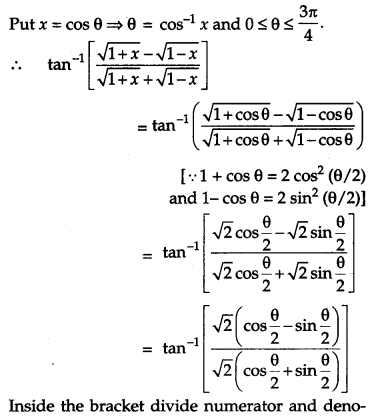
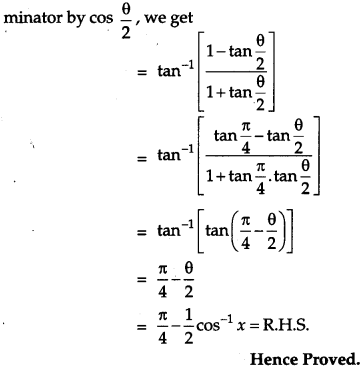
Question 13.
Using properties of determinants, solve the following for x:
 [4]
[4]
Solution:
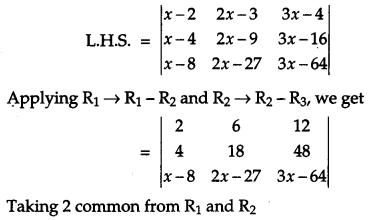
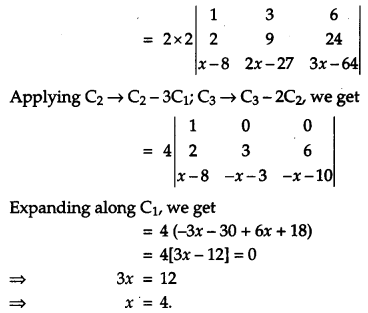
Question 14.
Find the relationship between ‘a’ and ‘b’ so that the function ‘f’ defined by:

is continuous at x = 3. [4]
Solution:
∵ f(x) is continuous at x = 3,
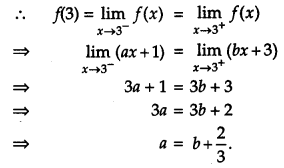
OR
If x
y
= e
x-y
, show that \(\frac{d y}{d x}=\frac{\log x}{(\log (x e))^{2}}\).
Solution:
We have,
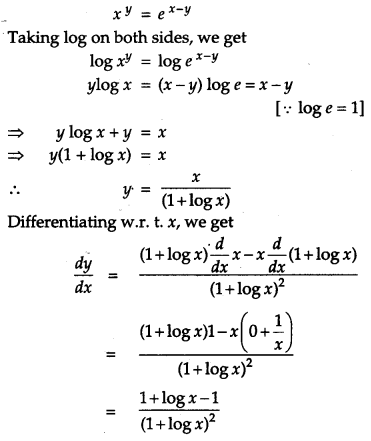

Question 15.
Prove that y = \(\frac{4 \sin \theta}{(2+\cos \theta)}-\theta\) is an increasing function on \(\left[0, \frac{\pi}{2}\right]\). [4]
Solution:
We have,
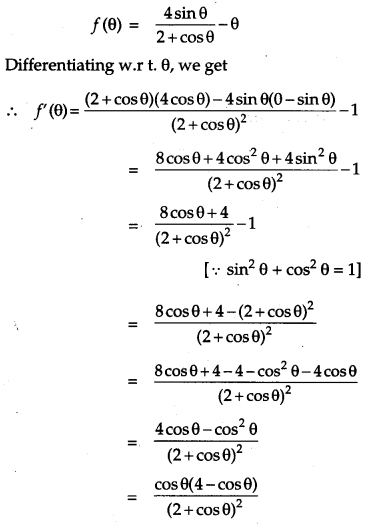
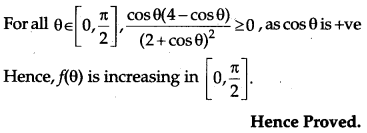
OR
If the radius of a sphere is measured as 9 cm with an error of 0.03 cm, then find the approximate error in calculating its surface area.
Solution:
Let r be the radius of sphere and ∆r be the error in measuring the radius.
Then r = 9 cm, ∆ r = 0.03 cm.
Now surface area S of the sphere is
S = 4πr
2
Differentiating w.r. t r, we get
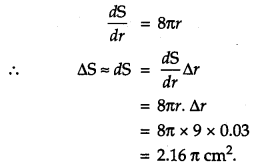
This is the approximate error in calculating surface area.
Question 16.
If x = \(\tan \left(\frac{1}{a} \log y\right)\), show that
 [4]
[4]
Solution:
Given,
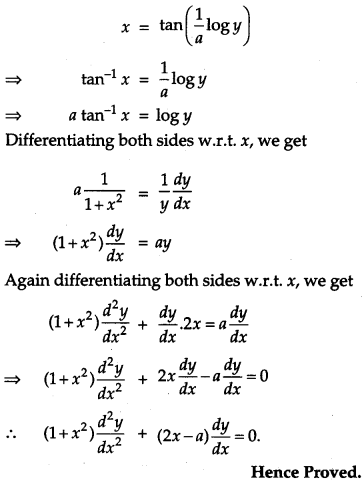
Question 17.
Evaluate:
![]() [4]
[4]
Solution:
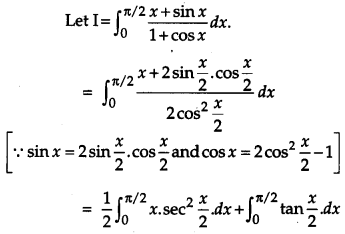
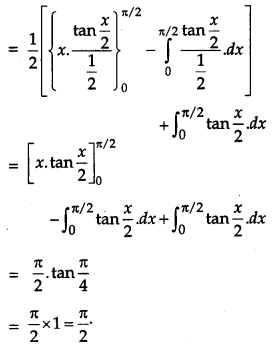
Question 18.
Solve the following differential equation :
![]() [4]
[4]
Solution:
The given differential equation is
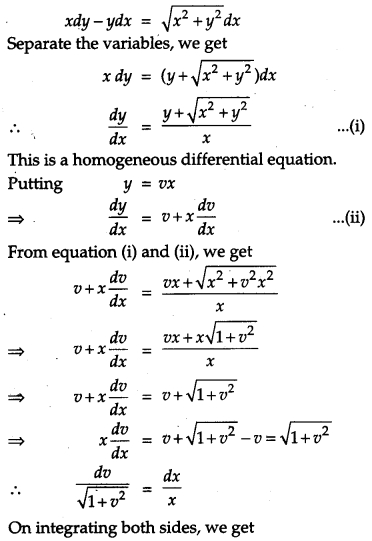
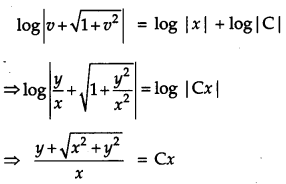
![]()
Question 19.
Solve the following differential equation:
![]() [4]
[4]
Solution:
The given differential equation is
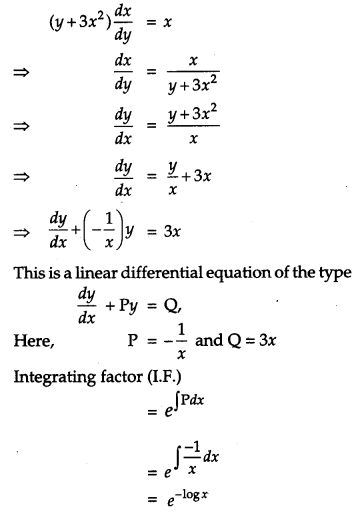
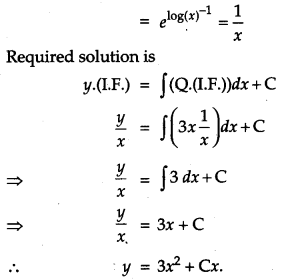
Question 20.
Using vectors, find the area of the triangle with vertices A(1, 1, 2), B(2, 3, 5) and C(1, 5, 5). [4]
Solution:
The vertices of triangle ABC are given as A(1, 1, 2), B(2, 3, 5) and C(1, 5, 5)
Let O be the origin of triangle

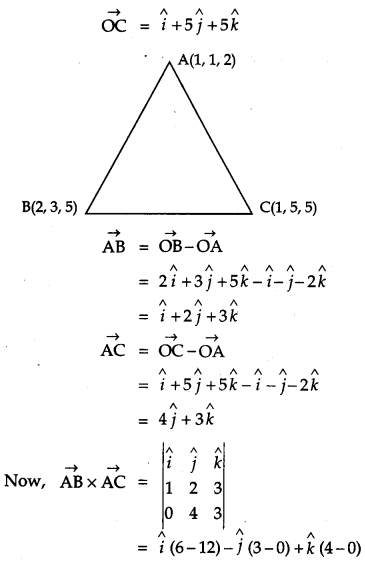
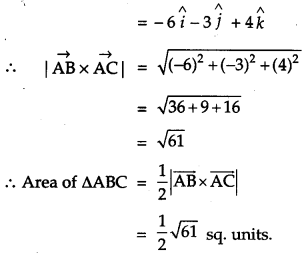
Question 21.
Find the shortest distance between the following lines whose vector equations are:
 [4]
[4]
Solution:
Given equation are

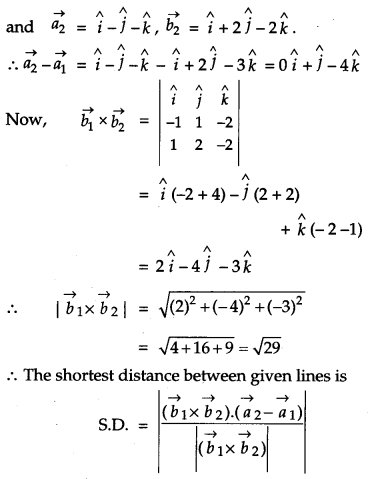
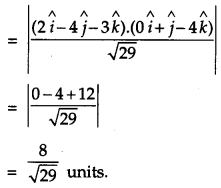
Question 22.
A random variable X has the following probability distribution:

Determine: [4]
(i) K
(ii) P(X < 3)
(iii) P(X > 6)
(iv) P(0 < X < 3).
Solution:
It is known that the sum of probability distribution of variable is one.
(i) ∴ Σ P(X) =1 .
Therefore,
P(0) + P(1) + P(2) + P(3) + P(4) + P(5) + P(6) + P(7) = 1
0 + K + 2K + 2K + 3K + K
2
+ 2K
2
+ 7K
2
+ K = 1
⇒ 10K
2
+ 9K – 1 = 0
⇒ 10K
2
+ 10K – K – 1 = 0
⇒ 10K (K +1) – 1(K + 1) = 0
⇒ (K +1) (10 K – 1) = 0
⇒ K + 1 = 0
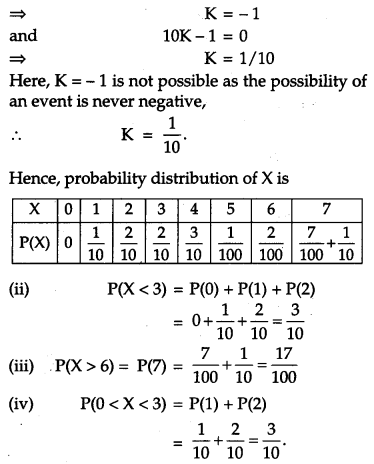
OR
Find the probability of throwing at most 2 sixes in 6 throws of a single die.
Solution:
Here, n = 6
p = p (getting 6)
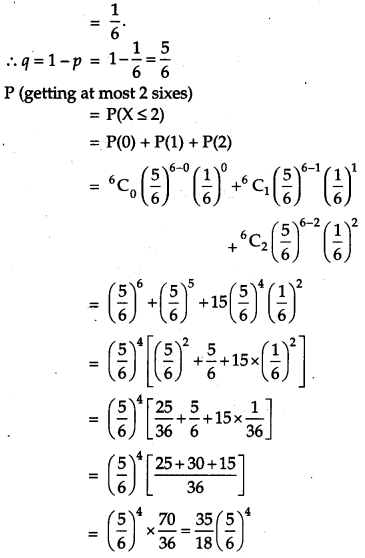

Section – C
Question 23.
Using matrices, solve the following system of equations:
4x + 3y + 2z = 60
x + 2y + 3z = 45
6x + 2y + 3z = 70. [6]
Solution:
4x + 3y + 2z =60,
x + 2y + 3z = 45,
6x + 2y + 3z = 70.
The equation of system can be written in matrix form
AX = B ….(i)
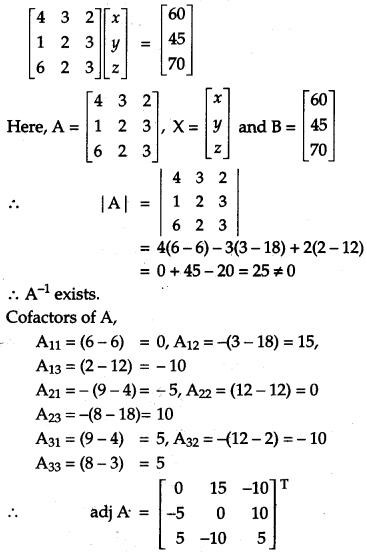
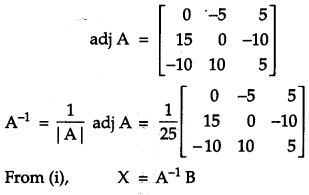
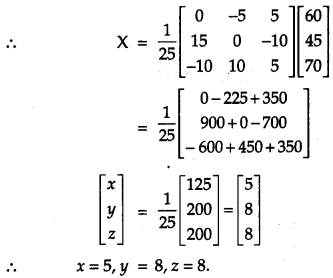
Question 24.
Show that the right circular cone of least curved surface and given volume has an altitude equal to \( \sqrt{{2}} \) times the radius of the base.
Solution:
Let radius of cone = r
Height of cone = h
and slant height of cone = l
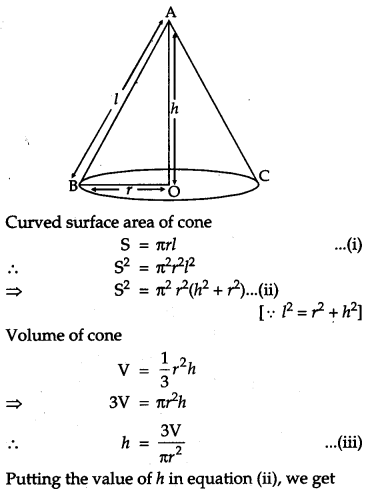
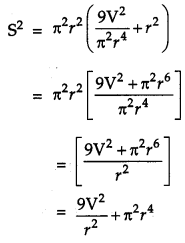
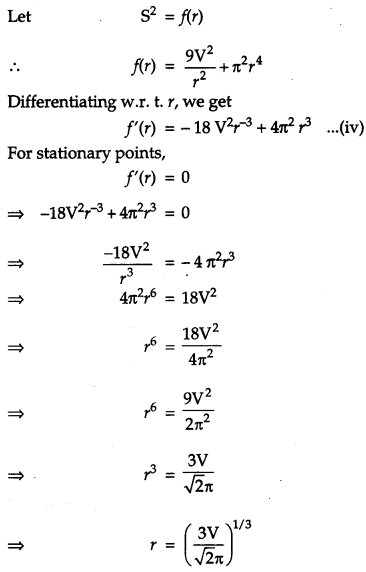
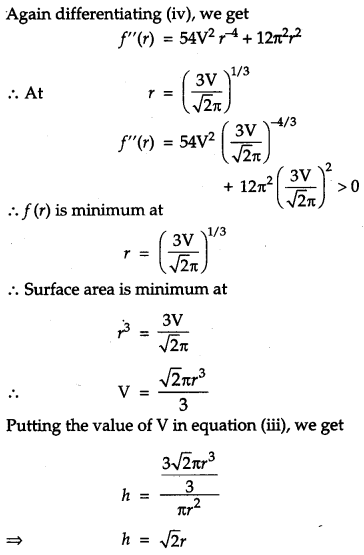
Hence, altitude is equal to \( \sqrt{{2}} \) times the radius of base. Hence Proved.
OR
A window has the shape of a rectangle surmounted by an equilateral mangle. If the perimeter of the window is 12 m, find the dimensions of the rectangle that will produce the largest area of the window.
Solution:
Let ABCD be a rectangle and let the side of an equilateral triangle be AB = b (length of the rectangle) and BC = a(width of the rectangle)
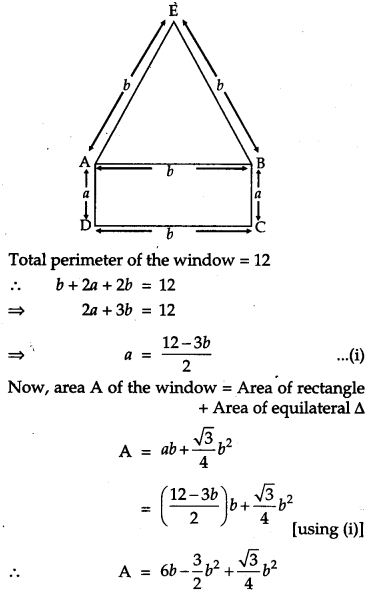
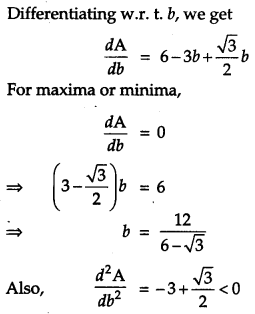
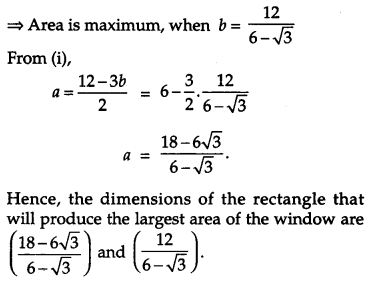
Question 25.
Evaluate:
 [6]
[6]
Solution:
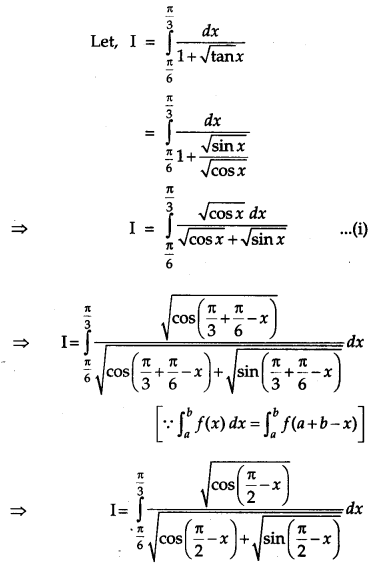
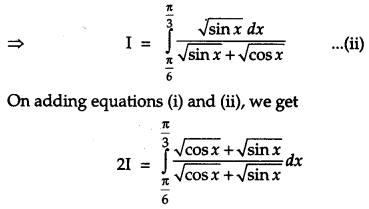
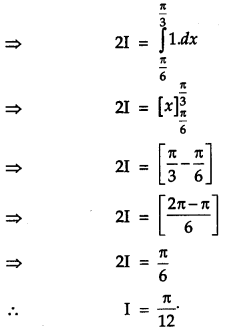
OR
Evaluate:

Solution:
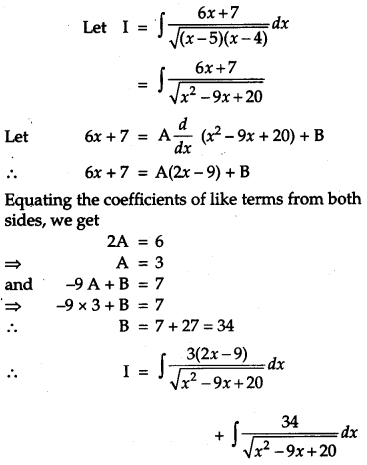
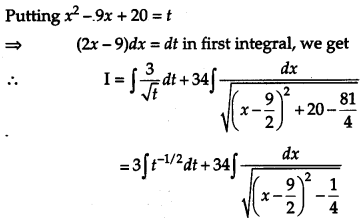
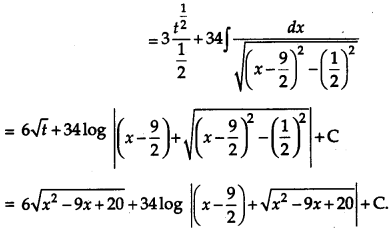
Question 26.
Sketch the graph of y = | x + 3| and evaluate the area under the curve y= | x + 3| above x-axis and between x = – 6 to x = 0. [6]
Solution:
For drawing a sketch of the graph of y = | x + 3|, we construct the following table of values
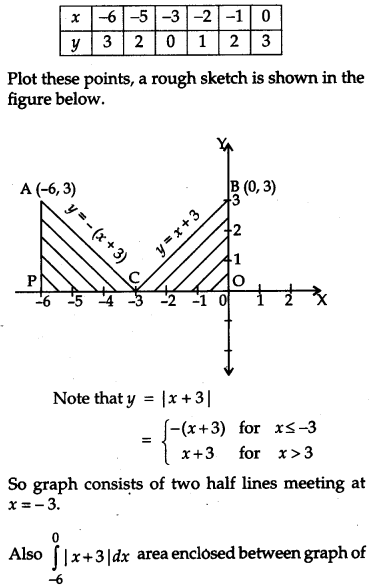

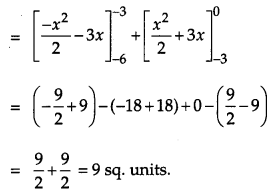
Question 27.
Find the distance of the point (-1, -5, -10), from the point of intersection of the line

Solution:
Equation of the line is
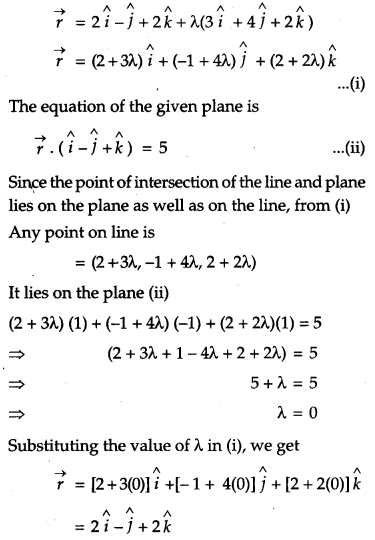
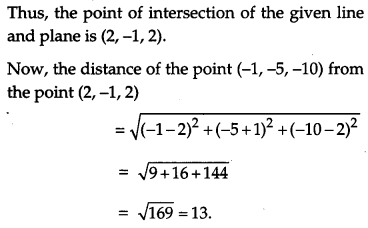
Question 28.
Given three identical boxes I, II and III each containing two coins. In box I, both coins are gold coins, in box II, both are silver coins and in box III, there is one gold and one silver coin. A person chooses a box at random and takes out a coin. If the coin is of gold, what is the probability that the other coin in the box is also of gold ? [6]
Solution:
Let E
1
i be box I is chosen, E
2
be box II is chosen and E
3
be box HI be chosen and A be the coin drawn is of gold.
We have,
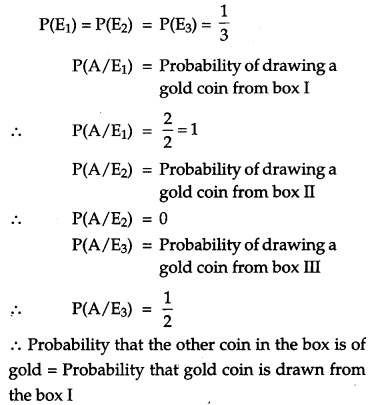
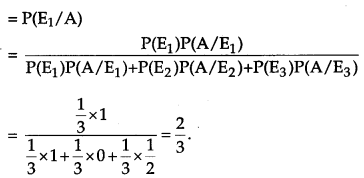
Question 29.
A merchant plans to sell two types of personal computer- a desktop model and a portable model that will cost ₹ 25,000 and ₹ 40,000 respectively. He estimates that the total monthly demand of computers will not exceed 250 units. Determine the number of units of each type of computers which the merchant should stock to get maximum profit if he does not want to invest more than ₹ 70 lakhs and his profit on the desktop model is ₹ 4,500 and on the portable model is ₹ 5,000. Make an L.P.P. and solve it graphically. [6]
Solution:
Let the merchant stock x desktop computers and y portable computers. We construct the following table :

∴ The LPP is
Maximize Z = 4,500 x + 5,000 y
Subject to constraints:
x + y ≤ 250
25,000 x + 40,000 y ≤ 70,00,000
⇒ 5x + 8y ≤ 1,400
and x ≥ 0 , y ≥ 0
First we draw the lines AB and CD whose equations are
x + y = 250 …(i)
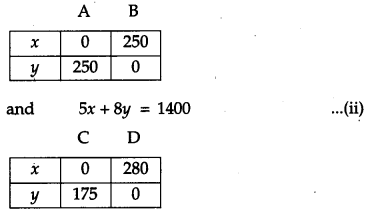
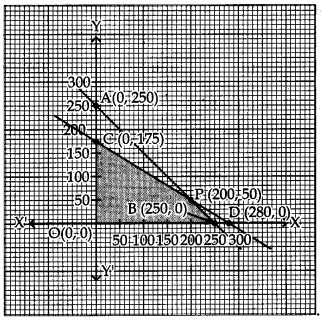
The feasible region is OBPCO which is shaded in the figure.
The vertices of feasible region are O(0, 0), B(250, 0), P(200, 50) and C(0, 175).
P is the point of intersection of the lines.
x + y = 250
and 5x + 8y = 1400
Solving these equation we get point P(200, 50).
∴ The value of objective function
Z = 4500 x + 5000y
At these vertices are as follows :
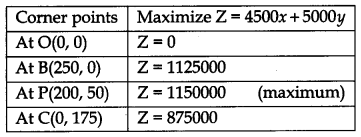
Hence, the profit is maximum at ₹ 11,50,000 when 200 desktop computers and 50 portable computers are stocked.
CBSE Previous Year Question Papers Class 12 Maths 2011 Outside Delhi Set II
Note: Except for the following questions, all the remaining questions have been asked in previous set.
Section – A
Question 9.
Evaluate:
 [1]
[1]
Solution:
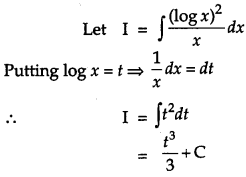

Question 10.
Write a unit vector in the direction of the vector
![]() [1]
[1]
Solution:
The given vector is
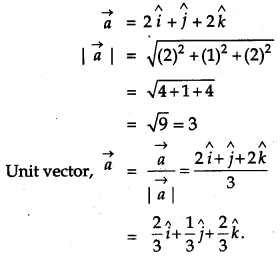
Section – B
Question 19.
Prove the following:
![]() [4]
[4]
Solution:
L.H.S
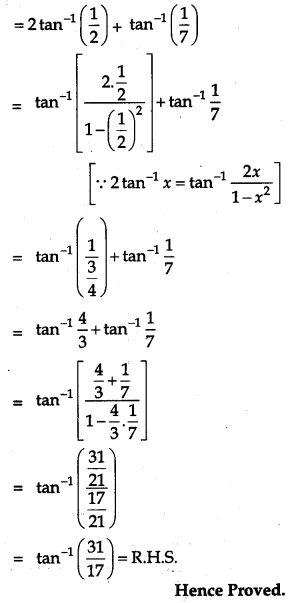
Question 20.
Using properties of determinants, solve the following for x:
 [4]
[4]
Solution:
The determinant is
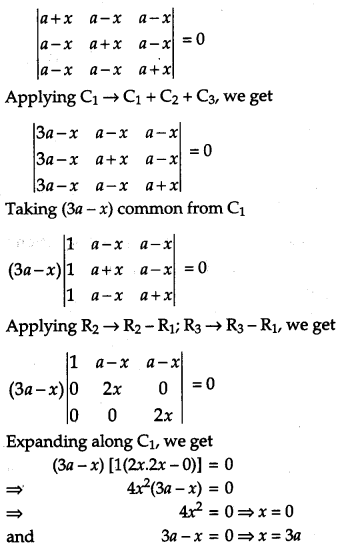
Question 21.
Evaluate:
 [4]
[4]
Solution:
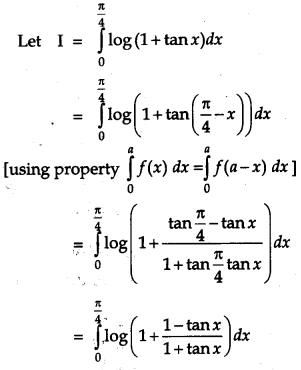
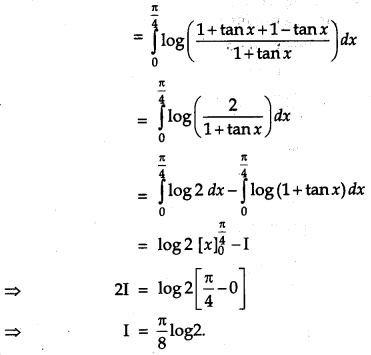
Question 22.
Solve the following differential equation:
xdy – (y + 2x
2
)dx = 0 [4]
Solution:
Given,
xdy – (y + 2x
2
)dx = 0
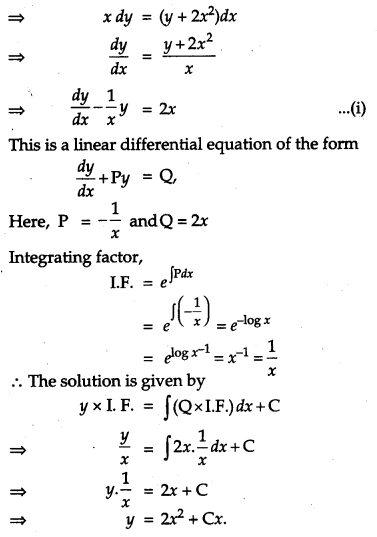
Section – C
Question 28.
Using matrices, solve the following system of equations: [6]
x + 2y + z = 7
x + 3z =11
2x – 3y = 1
Solution:
The given equations are x + 2 y + z = 7
x + 3z = 11
2x – 3y = 1
The given system of equations can be written in matrix form
AX = B …(i)
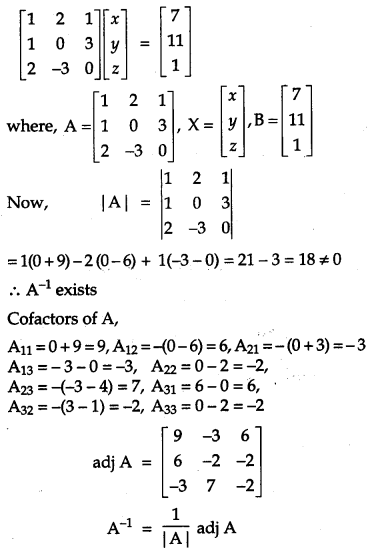
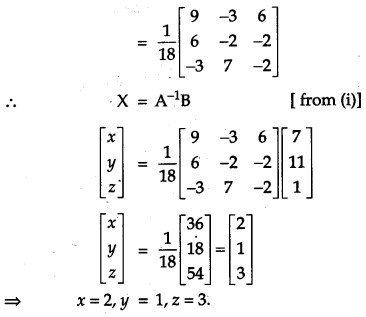
Question 29.
Find the equation of the plane passing througjh the line of intersection of the planes \(\vec{r} \cdot(\hat{i}+\hat{j}\)\(+\hat{k})=1 \text { and } \vec{r} \cdot(2 \hat{i}+3 \hat{j}-\hat{k})+4=0\) and parallel to x-axis. [6]
Solution:
The given equation of planes are
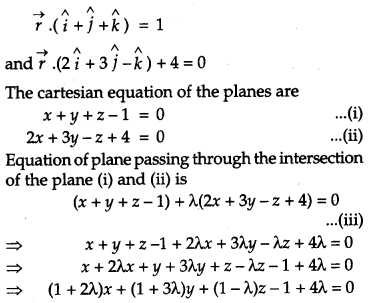
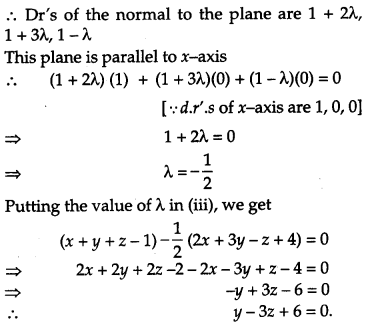
CBSE Previous Year Question Papers Class 12 Maths 2011 Outside Delhi Set III
Note : Except for the following questions, all the remaining questions have been asked in previous sets.
Section – A
Question 1.
Evaluate:
 [1]
[1]
Solution:
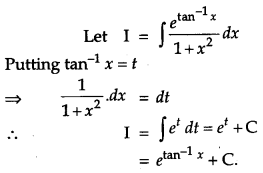
Question 2.
Write the angle between two vectors \(\vec{a}\) and \(\vec{b}\) magnitudes with \(\sqrt{3}\) and 2 respectively having \(\vec{a} \cdot \vec{b}=\sqrt{6}\). [1]
Solution:
Given,
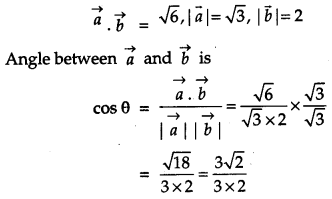

Section – B
Question 11.
Prove that: \(\tan ^{-1}\left(\frac{1}{2}\right)+\tan ^{-1}\left(\frac{1}{5}\right)+\tan ^{-1}\left(\frac{1}{8}\right)=\frac{\pi}{4}\). [4]
Solution:
L.H.S
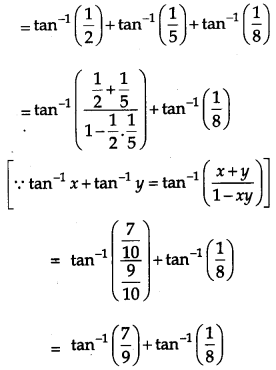
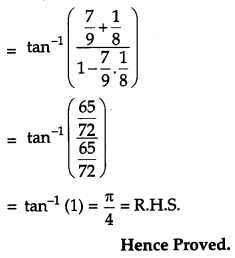
Question 12.
Using properties of determinants, solve the following for x:
 [4]
[4]
Solution:
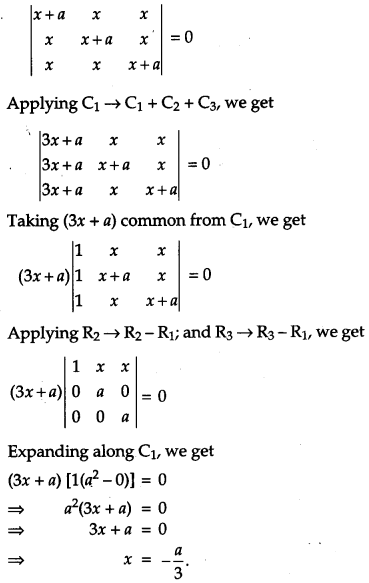
Question 13.
Evaluate:
 [4]
[4]
Solution:

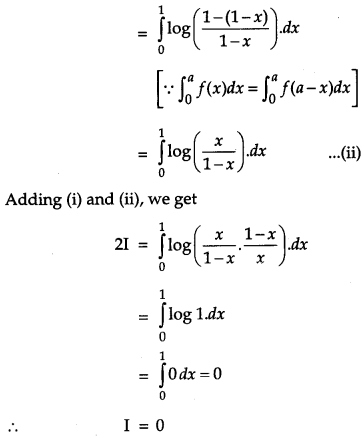
Question 14.
Solve the following differential equation:
xdy + (y – x
3
)dx = 0 [4]
Solution:
We have,
xdy + (y – x
3
)dx = 0
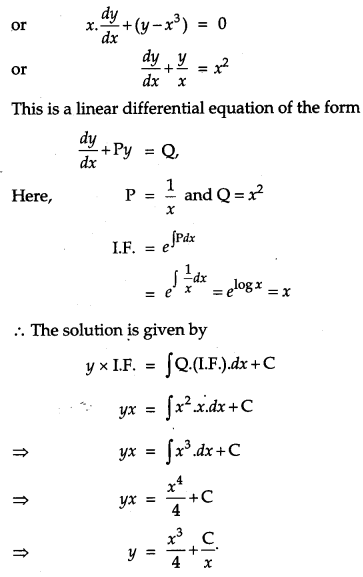
Section – C
Question 23.
Using matrices, solve the following system of equations: [6]
x + 2y – 3z = -4
2x + 3y + 2z = 2
3x – 3y – 4z = 11
Solution:
The given system of equations can be written in matrix form as
AX = B …(i)
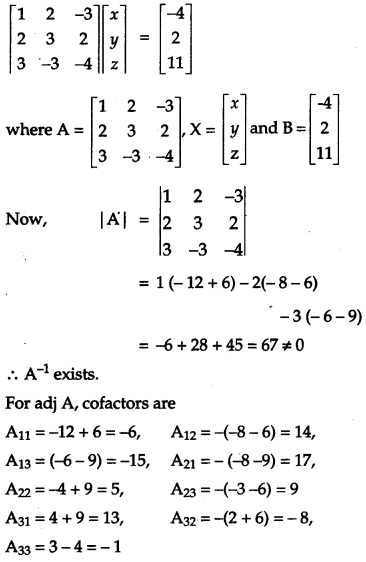
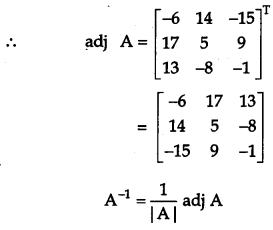
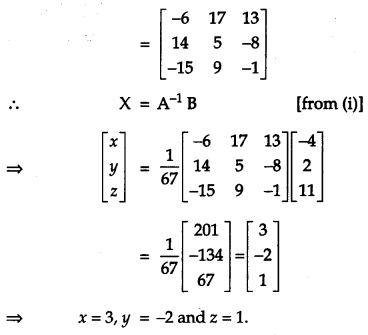
Question 24.
Find the equation of the plane passing through the line of intersection of the planes 2x + y – z = 3 and 5x – 3y + 4z + 9 = 0 and parallel to the line
![]() [6]
[6]
Solution:
Given planes are
2x + y – z – 3 = 0 …..(i)
5x – 3y + 4z + 9 = 0 …..(ii)
Any plane passing through the line of intersection of (i) and (ii) can be taken as
2x + y – z – 3 + λ(5x – 3y + 4z + 9) = 0
(2 + 5λ)x + (1 – 3λ)y + (-1 + 4λ)z – 3 + 9λ = 0 …(iii)
The plane is parallel to the line
